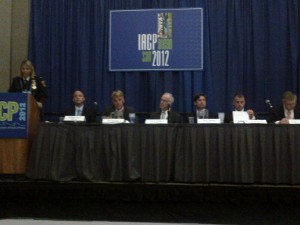By Leischen Stelter
What have we learned from the 2008 Mumbai attacks, which consisted of 11 coordinated shooting and bombing attacks across India’s largest city? How can law enforcement agencies, first responders and cities be better prepared to respond to an incident of this scale?

Those were the questions addressed during a panel discussion at the 2012 International Association of Chiefs of Police conference in San Diego titled ‘Preparing for a Coordinated Attack.’
Lieutenant Tracy Frazzano with the Montclair, N.J. Police Department has been dedicated to better preparing police agenices in cities around the country for such coordinated attacks. She is a fellow with the Federal Emergency Management Agency who is assisting with the Joint Counterterrorism Awareness Workshop Series (JCTAWS).
So far, there have been six JCTAWS workshops held throughout the United States. These workshops present a 24-hour scenario in which multiple coordinated attacks occur, much like the terrorist attacks in Mumbai. The workshop includes representatives from law enforcement, fire service, emergency management, fusion centers, public health agencies, transportation agencies and others private sector organizations to gauge their response capabilities and resources. At the conclusion of each workshop, the city is issued a summary report that identifies trends, lessons learned and best practices for ways to improve their response to such multi-site attacks.
The strongest message from the panel discussion was the need to change the response paradigm and the roles of these different agencies. Dr. Reed Smith, operational medical director of the Arlington County, Virginia Fire Department, summed it up nicely:
“What we must do is change the response paradigm and adapt our conventional roles to this new threat. Part of that starts pre-event, with cross training and communication at all levels, down to the line officers in the police and fire departments. We need to accept these new roles in response—it’s not ‘do your part and I’ll do mine’ anymore—we have to understand ALL the operational roles.”
One of the biggest hurdles to effectively responding to massive, coordinated terrorist attacks is that many players are resisting such a paradigm change, he said, and resisting a redefinition of their traditional roles.
“Police must be cross trained in fire ground tactics and operations, they must be cross trained in the language of fire response and in fire behavior. It’s important for police to understand offense and defense. The key is breaking down these paradigms and being innovative,” said Dr. Reed.
And it’s not just first responders who have a role in preparing and responding to such events, the public sector has a significant role to play, too.
“The private sector interaction in all these events has been eye opening not only for us at the federal level, but also for the cities themselves,” said Anthony Vassalo, chief of the counterterrorism group with the National Counterterrorism Center.
The first step is often getting past denial and conveying to management and employees why private entities might be a target for such an attack.
“We need them to understand what surveillance looks like and have discussions with employees to get them to understand what to look for, similar to the ‘See Something, Say Something’ campaign,” Vassalo said.
The point of these JCTAWS events is to get all of these agencies and organizations to work and train together, said Art Zarone with the FBI. “Start by responding to mundane events and then take on increasingly complex capabilities,” he said. “We also recommend a liberal sprinkling of planning or tabletop exercises as the city’s plan matures.” Here is where all the gaps are identified and worked out. Be sure to include communication networks as part of the training, too. “Don’t ad lib or take short cuts. Find work-arounds and figure out what works when radios aren’t communicating and what your options are,” Vassalo said.
It may surprise you that one of the biggest hurdles during these workshops is simply the fact that participants are TOO cooperative. “We’ve had many experiences where those participating in the exercise are too generous and participants are too nice to each other,” said Corey Gruber, assistant administrator with FEMA. That’s why performing “no notice” exercises or changing the scenario is important. It’s also critical to test these agencies plans to the breaking point so then they’ll know how they’ll weather a real scenario. This builds the confidence of the command and operations team and prepares them for the real thing, said Gruber.
As JCTAWS workshops continue to be held throughout the country, responding agencies and organizations will learn more and more valuable lessons about how to respond to coordinate attacks more effectively.
Is you agency prepared to respond to such a scenario?
Comments are closed.